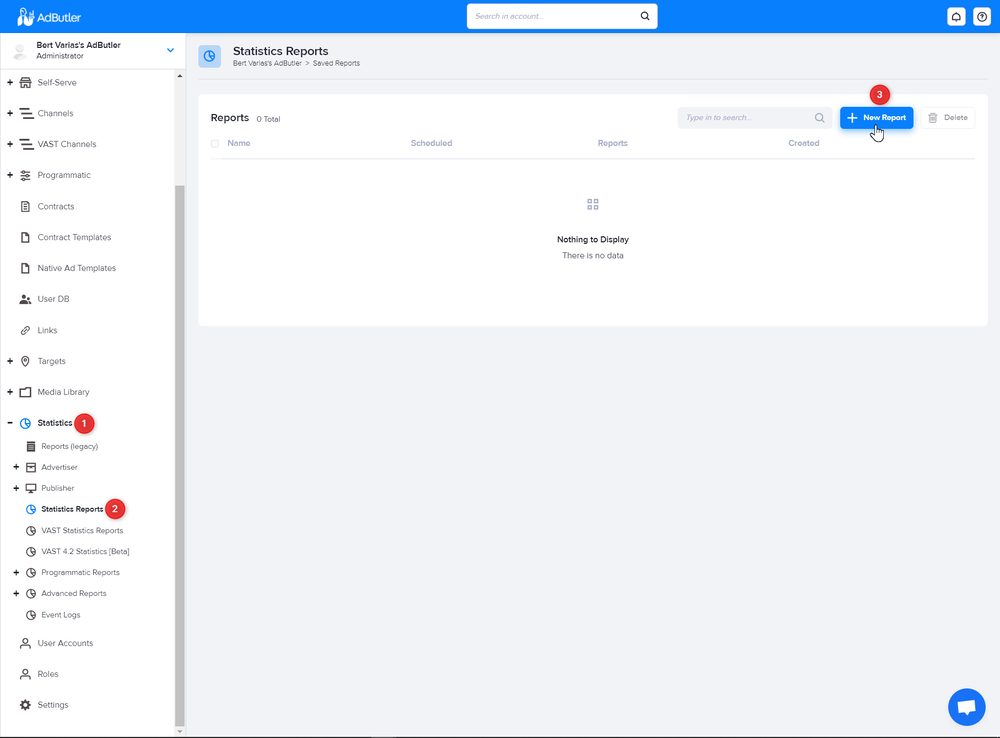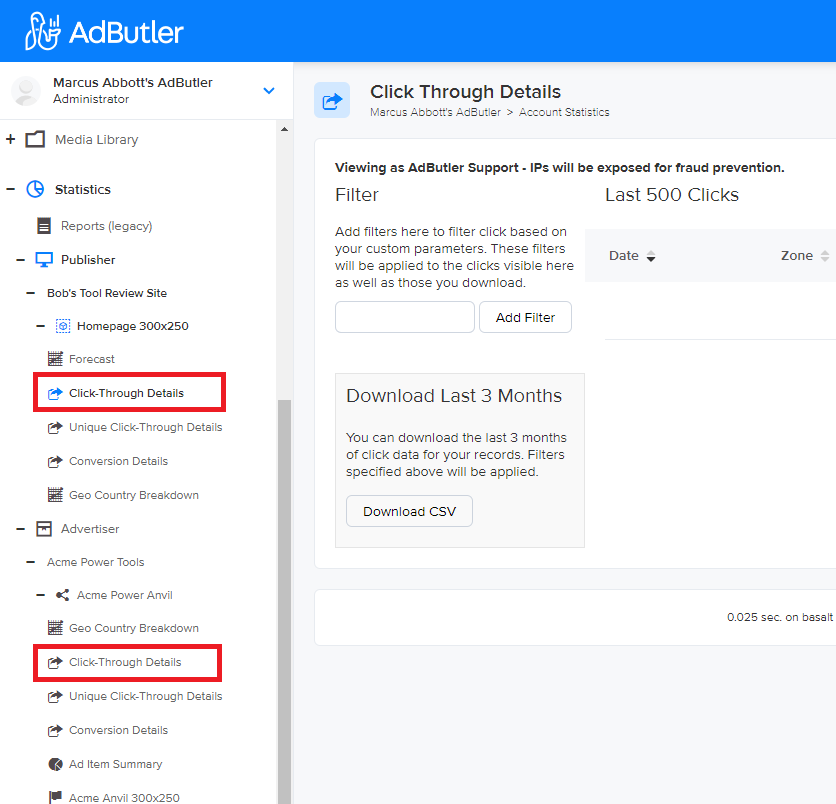How to create custom reports
This guide will teach you how to use the Statistics Reports sub-section under Statistics. This is where you can create, download, and schedule emails of custom reports.
To learn how to create custom reports about VAST ads, read How to create VAST reports.
- How to create a custom report.
- How to save a report.
- How to download a report.
- How to send reports regularly via email.
- About the metrics and other information in a report.
How to create a custom report
- Click on Statistics near the bottom of the left navigation menu, then click on Statistics Reports. The Statistics Reports subsection will appear.

- Click on New Report. The New Report page will appear.

Here are the filters that you can use to specify the contents of your report:
- Report - This is where you choose the subject of the report. The report can feature data about ad items, campaigns, zones, publishers, advertisers, geographic targets, or an overview.
- Gear icon - This is where you choose which metrics or information to include in the report. Simply check or uncheck the options to include or exclude them, respectively. See The information and metrics in a custom report for details.
- Filters - This is where you can further narrow down the included subjects of the report. Let's say you have three Publishers in your account, but you want to create a report about only one of them. To do so, Choose Publishers under Report. Then click on the Publishers dropdown menu under Filters and uncheck the names of the two publishers that you wish to exclude from the report. You can apply multiple filters to a single custom report.
- Dates - This is where you specify the period that will be covered in the report. The first dropdown menu is where you enter a start date and an end date, or simply choose from the various preset periods. The second dropdown menu is where you choose how the information will be broken down - as a summary, daily, monthly, yearly, or based on a specific day of the week. The clock icon is where you choose the time zone that will be used as the basis for the report.
After you've selected your filters, click Generate Report. Your custom report will load shortly at the bottom of the page. If you're not satisfied with the generated report, simply make your changes then click Generate Report again.
Once you are satisfied with the generated report, you have three more optional actions that you can take. You can save the report, download the report, and tell AdButler to regularly generate and email the report.
How to save a report
Click Save this report to save the set of filters you chose for future use. You will be prompted to name the custom report. You can save multiple custom reports. To load a saved report, simply click Load Settings...
How to download a report
Click Download as CSV to download the generated report (the one that is currently displayed at the bottom of the page) as a CSV file.
How to send reports regularly via email
AdButler can automatically generate and email custom reports on a regular basis. To enable this feature, you must first save the report that you want to email on a regular basis. Once you have saved the report (or loaded a saved report), click Schedule this report to show the scheduling window.
- Give the regular report a name. It can be different from the name you used to save the report.
- Choose how often AdButler will email the report.
- Choose when AdButler will start sending the report.
- Enter the email addresses of the people who will receive the report. Click +Add another recipient to add more email addresses. The recipients don't need to have AdButler accounts.
- Choose what link the recipient will receive. The first option is a link to a page where they can view and download a CSV copy of the report. The second option is a link to a page where the recipient can only download a CSV copy of the report.
The information and metrics in a custom report
These are the possible details - presented as columns - that you can include in a custom report. Note that some of them are applicable only to certain subjects or only within certain periods. For example, you may have campaigns in which conversions and the conversion rate (CVR) are not relevant, or will always be zero.
The rows in a custom report are arranged chronologically by default. You can rearrange the order of the rows by clicking on the name of a column. For example, clicking on Eligible will sort the rows by descending order of eligible impressions. Clicking on Eligible again will sort the rows by ascending order of their eligible impressions.

Date
This is a mandatory column. It's the default way by which the report is organized, and easily lets you pinpoint trends if there are any.
Parent
This is a mandatory column. This contains the subject of the report. For example, if you chose ad items to be the subject of your report, then each row in the Parent column will list a specific ad item, and the rest of the details in that row will pertain to that ad item.
Total Impr. (Total impressions)
This indicates how many times AdButler delivered an ad to the requesting site or app within the chosen period. Depending on your setup, this metric may not be accurate. For more information, read Requests vs. Impressions and VAST Impressions vs. Requests.
Eligible (Eligible impressions)
This indicates how many times a given ad was successfully rendered on the publisher's page or app within the chosen period. This is more meaningful than the total impression count, since it assures that the ad was rendered. However, this metric can be measured only on standard zones that use either a regular or asynchronous JavaScript zone tag. For more information, read Viewability.
Viewable (Viewable impressions)
A viewable impression is counted when at least 50% of the ad has been in the visible part of the page or app for at least one second. In other words, this metric tracks if the viewer has actually seen a good portion of the ad. This means that all Viewable Impressions are also Eligible Impressions, but the opposite is not necessarily true.
Viewable Impressions are more meaningful compared to both Eligible Impressions and the total impression count when considering the effectiveness of your partnership with a publisher, or the ability of your ad to keep audiences engaged. However, as with Eligible Impressions, this metric can be measured only on standard zones that use either a regular or asynchronous JavaScript zone tag. For more information, read Viewability.
Viewable CTR (Viewable Click-through rate)
This is the percentage of people who clicked on the ad among the number of viewable impressions within the chosen period. Its formula is Clicks/Viewable impressions.
Clicks
This simply indicates how many times the ad was clicked within the chosen period.
Conv. (Conversion)
This refers to a viewer action directly resulting from clicking an ad. In other words, this is the ultimate goal of your ad. Examples of a conversion include the customer clicking your ad and then making a purchase from your store, signing up for your newsletter, or downloading your application on the page to which they were taken. Naturally, not all ads have an applicable conversion goal.
CTR (Click-through rate)
This is the percentage of people who clicked on the ad among the number of impressions within the chosen period. Its formula is Clicks/Total impressions.
CVR (Conversion ratio)
This is the percentage of people who clicked on the ad and took your desired action (as discussed in Conversion) among the number of impressions within the chosen period.
eCPM (Effective Cost per mille)
This is how much the publisher earned from ad impressions within the chosen period. Its formula is (Ad revenue/Total impressions) x 1,000. It's best to think of eCPM as the average of multiple CPMs. This is especially important in programmatic setups because different advertisers (the bidders) will have different CPMs.
eCPC (Effective Cost per click)
This is how much the publisher earned from clicks within the chosen period. Its formula is Ad revenue/Clicks. It's best to think of eCPC as the average of multiple CPCs. This is especially important in programmatic setups because different advertisers (the bidders) will have different CPCs.
eCPA (Effective Cost per action)
This is how much the publisher earned from conversions within the chosen period. Its formula is Ad revenue/Conversions. It's best to think of eCPA as the average of multiple CPAs. This is especially important in programmatic setups because different advertisers (the bidders) will have different CPAs.
Payout
This is how much the publisher will earn based on the values that were entered in the Financial section when the campaign or ad item was assigned to a zone. For more information, read About Assignments and Financial settings.
Publisher ID
This is the unique ID of the publisher that owns the zone where the ad was served.
publisherID in your browser's address bar.
Revenue
This is how much the Administrator will earn based on the values that were entered in the Financial section when the campaign or ad item was assigned to a zone. For more information, read About Assignments and Financial settings.
Click-Through Details
This is an additional table that shows information about the viewers that clicked on your ads. This table is actually accessible via the Publishers and Advertisers sub-sections, and not through Statistics Reports, but it might be relevant to your analysis as well.
